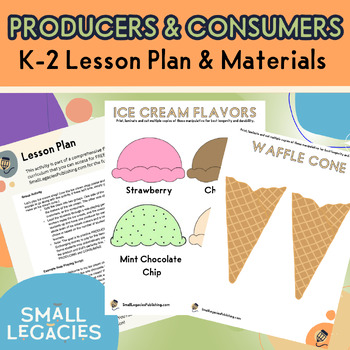Imaginative Play Montessori Manipulatives - Producers and Consumers Lesson
Small Legacies - Financial Literacy
3 Followers
Grade Levels
PreK - 2nd, Homeschool
Subjects
Resource Type
Standards
CCSSK.CC.B.4
CCSSK.CC.B.5
CCSSMP2
CCSSMP4
Formats Included
- PDF
Pages
9 pages
Small Legacies - Financial Literacy
3 Followers
What educators are saying
I absolutely love this resource. My students were engaged the whole time. This resource really helped my students grasp the concept of money.
Description
Be sure to visit Small Legacies on YouTube for the full lesson video that accompanies this activity!
Teach Kindergartners, first grades and second graders about Producers and Consumers using imaginary play! These colorful printables will help students understand core financial literacy curriculum concepts while maintaining age-appropriate creative, open exploration.
Full Activity Description and Lesson Plan Included.
Total Pages
9 pages
Answer Key
N/A
Teaching Duration
30 minutes
Report this resource to TPT
Reported resources will be reviewed by our team. Report this resource to let us know if this resource violates TPT’s content guidelines.
Standards
to see state-specific standards (only available in the US).
CCSSK.CC.B.4
Understand the relationship between numbers and quantities; connect counting to cardinality.
CCSSK.CC.B.5
Count to answer “how many?” questions about as many as 20 things arranged in a line, a rectangular array, or a circle, or as many as 10 things in a scattered configuration; given a number from 1-20, count out that many objects.
CCSSMP2
Reason abstractly and quantitatively. Mathematically proficient students make sense of quantities and their relationships in problem situations. They bring two complementary abilities to bear on problems involving quantitative relationships: the ability to decontextualize-to abstract a given situation and represent it symbolically and manipulate the representing symbols as if they have a life of their own, without necessarily attending to their referents-and the ability to contextualize, to pause as needed during the manipulation process in order to probe into the referents for the symbols involved. Quantitative reasoning entails habits of creating a coherent representation of the problem at hand; considering the units involved; attending to the meaning of quantities, not just how to compute them; and knowing and flexibly using different properties of operations and objects.
CCSSMP4
Model with mathematics. Mathematically proficient students can apply the mathematics they know to solve problems arising in everyday life, society, and the workplace. In early grades, this might be as simple as writing an addition equation to describe a situation. In middle grades, a student might apply proportional reasoning to plan a school event or analyze a problem in the community. By high school, a student might use geometry to solve a design problem or use a function to describe how one quantity of interest depends on another. Mathematically proficient students who can apply what they know are comfortable making assumptions and approximations to simplify a complicated situation, realizing that these may need revision later. They are able to identify important quantities in a practical situation and map their relationships using such tools as diagrams, two-way tables, graphs, flowcharts and formulas. They can analyze those relationships mathematically to draw conclusions. They routinely interpret their mathematical results in the context of the situation and reflect on whether the results make sense, possibly improving the model if it has not served its purpose.



